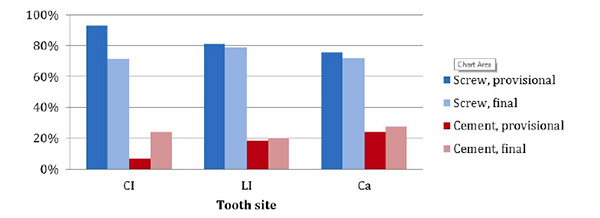CONTROL ID: 2603924
CONTACT: Tamsin Cracknell
Abstract Details
CURRENT CATEGORY: Clinical
PRESENTATION TYPE: Poster
Abstract
TITLE:
Relative Incidence of Screw versus Cement Retention in Provisional and Final Single Crowns in the Anterior Maxilla
AUTHORS: Cracknell, Tamsin; Meltzer, Alan M.; Zamzok, Jonathan; Chu, Stephen J.
ABSTRACT BODY:
Introduction: Screw-retention of crowns allows ease of maintenance, retrieval, and minimizes complications caused by cement particles. However, cement retention is often dictated for tapered, palatally placed implants in the anterior maxilla, because the screw will emerge on the incisal edge if the implant is inclined too far facially. This retrospective study aimed to correlate the incidence of screw- vs cement-retention in provisional/definitive single anterior maxillary crowns to tooth site and implant diameter.
Method:
275 single tooth implants were placed into either a maxillary central incisor (CI; 57%), lateral incisor (LI; 29%) or canine (Ca; 14%) extraction socket with intentional palatal placement. Implants received a screw- or cementretained provisional restoration, followed by a definitive crown. Implant diameters ranged from 3.25-6.5mm (median 4.00mm). Effect of tooth site (CI, LI or Ca) and of implant diameter on retention method was analyzed using the chisquared test.
Results:
240 out of 275 (87%) implants received screw-retained provisional restorations with the remainder cementretained (n=35; 13%). 202 out of 275 (76%) definitive restorations were screw-retained and the remainder cementretained (24%). Therefore 38 (16%) screw-retained provisionals changed to cemented definitive crowns. These were almost exclusively CI sites (34 out of 38; 89%). Retention method was not significantly correlated to implant tooth site (provisional: p=0.86; definitive: p=0.34) or to implant diameter (provisional: p=0.12; final: p=0.73).
Conclusion:
The overall incidence of screw-retained provisional restorations was high at 87%. However, the incidence of screw-retained definitive restorations was only 76%. Central incisors accounted for 89% of screw-retained provisionals that required cemented final crowns. Contributing factors increasing the need for cement-retained definitive restorations were [1] less restorative flexibility of definitive materials, [2] tapered implant design and subcrestal placement, and [3] large screw access hole of most conventional implants.

Figure 1: Percentage of screw- vs cement-retained provisional and final restorations by tooth site.
#SouthernImplantsAbstracts #SouthernImplantsCitings #DentalImplant #SouthernImplants
